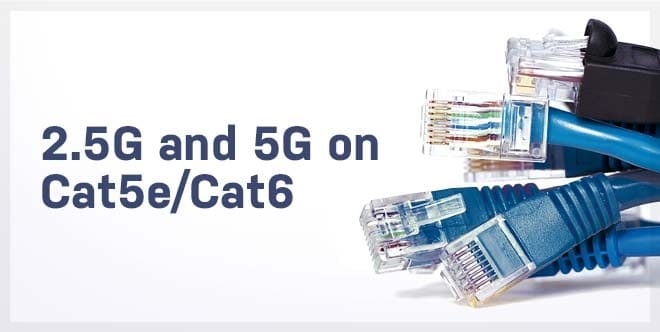Multigigabit Technology | Why Should I Care?
What it means:
Multigigabit technology and specifically the IEEE 802.3bz standard, formally introduced as 2.5GBASE-T and 5GBASE-T in 2016. IEEE 802.3bz is a standard for Ethernet over twisted pair copper wire at speeds of 2.5 Gbps and 5 Gbps. In 2016, the Institute of Electrical and Electronics Engineers (IEEE) released the IEEE 802.3bz standard, which defines parameters for 2.5-Gigabit and 5-Gigabit Ethernet connections over Category 5E and higher Ethernet cables. Multi-Gigabit Ethernet ports are backward compatible with standard 100 Mbps and Gigabit speeds.

Why you should care:
Gigabit connections have served us well for many years, delivering fast low-latency data to laptops, smartphones and other devices. However, the latest generation of APs can overwhelm a 1 GbE connection so that the wired network becomes a performance bottleneck. Multi-gigabit technology, which operate above 1 Gbps supports new data rates of 2.5 and 5 Gbps, while still leveraging commonly deployed Cat 5e (for 2.5 Gbps) or Cat 6 (for 5 Gbps) cabling. Thus, enterprises can maximize the performance of their Wi-Fi networks in the most cost-effective, least-disruptive manner. All OEM have access point support multi-gigabit technology / 802.3bz to help organizations maximize their Wi-Fi network performance.
How can I benefit from using Multi-Gigabit Ethernet Switches in my network?
Modern, high-performance network devices such as 5G network cards, gaming computers, desktop computers, servers, network attached storage (NAS) devices, or IEEE 802.11ac Wave 2 wireless access points are capable of 2.5-Gigabit or 5-Gigabit connectivity. With the existing Gigabit and 10-Gigabit Ethernet standards, these devices’ potential is wasted:
- The existing Gigabit and 10-Gigabit Ethernet standards do not allow speeds between 10 Gbps and 1 Gbps. If you connect an 802.11ac Wave 2 wireless access point or other Multi-Gigabit-capable device to a 10-Gigabit switch port, the connection automatically downgrades to 1 Gbps because the device cannot achieve 10 Gbps.
- The existing 10-Gigabit Ethernet standard requires Cat 6A or better Ethernet cable for lengths up to 100 meters (328 feet). However, most existing cabling is only Cat 5e or Cat 6, and re-wiring can be costly.

Multi-Gigabit Ethernet switching fixes both problems by allowing a connection to operate at any speed up to the speed of the connected switch port (2.5 Gbps or 5 Gbps) over a Cat 5e or Cat 6 Ethernet cable. With Multi-Gigabit Ethernet Switches, you can use the full power of your devices without running new cables. Just connect the appropriate port on your Multi-Gigabit Ethernet Switch to a Multi-Gigabit-capable device and your switch selects the fastest supported speed automatically.
Key benefits of Multigigabit Technology
Multigigabit technology offers significant benefits for a diverse range of speeds, cable types, and Power Over Ethernet (POE) power. The benefits can be grouped into three different areas: Multiple speeds: Multigigabit technology supports auto-negotiation of multiple speeds on switch ports. The supported speeds are 100 Mbps, 1 Gbps, 2.5 Gbps, and 5 Gbps on Cat 5e cable and up to 10 Gbps over Cat 6a cabling. Cable type: The technology supports a wide range of cable types including Cat 5e, Cat 6, and Cat 6a or above. POE power: The technology supports POE, POE+, and UPOE for all the supported speeds and cable types.

NBASE-T Alliance Celebrates Approval of 2.5/5G Ethernet Standard
The NBASE-T Alliance today celebrates the IEEE approval of IEEE 802.3bz™, a new standard that defines 2.5 and 5 Gigabit Ethernet speeds over the large installed base of twisted pair copper cabling (2.5GBASE-T and 5GBASE-T). The new standard offers seamless upgrade of older 1000BASE-T networks—a technology that was introduced nearly 20 years ago—and boosts the speed of many Ethernet networks up to five times with no changes to the cabling infrastructure. Final approval of the standard took place during the IEEE-SA Standards Board meeting held last week.
Established in October 2014, the NBASE-T Alliance has provided an open forum for building consensus around the development of the technology and the standard, and has helped members create specifications to facilitate product development. The NBASE-T specifications are consistent with the baselines adopted for the new IEEE 802.3bz standard and have resulted in the deployment of a variety of products ranging from chips and switches to cabling solutions, test equipment and more. As a result, the alliance has enabled an extensive ecosystem of products and rapid proliferation of the technology in advance of standards approval. Products developed using the NBASE-T specification are expected to be compatible with the IEEE standard via minor software upgrades.

What is Multigigabit Technology?
With the enormous growth of 802.11ac and new wireless applications, wireless devices are driving the demand for more network bandwidth. This creates a need for a technology that supports speeds higher than 1 Gbps on all cabling infrastructure. Multigigabit technology allows you to achieve bandwidth between speeds of 1 and 10 Gbps over traditional Cat 5e cabling or above. In addition, the multigigabit ports support Universal Power Over Ethernet (UPOE), which is increasingly important for next-generation workspaces and Internet of Things (IoT) ecosystems.
Why do I need Multigigabit Ethernet?
Would Multigigabit Ethernet require new cabling infrastructure?
Can I use a standard RJ45 connector to connect the cable to a multigigabit switch port?
What are the data rates and speeds supported with multigigabit technology?
How are they related?
Does the multigigabit switch port support a 10 Mbps data rate?
Will a multigigabit switch port auto-negotiate the link speed?
Multi-Gigabit Access Point
